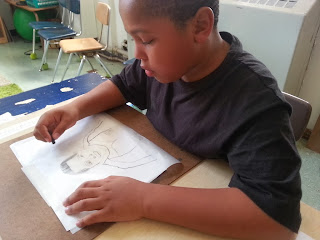I stumbled on these portraits outside of Andrew's class one day.
His students are expert portrait artists, I thought. I asked Andrew about their process. It started simply. Looking in the mirror, students explored their own features then made portraits in clay concentrating on getting the texture of their hair just right.
Next they travelled, physically and conceptually, back and forth in time, to focus on figurative sculpture from ancient Cyprus to modernist and contemporary painting and photography. At the Met they saw Cypriot sculptures and Chuck Close's work. (He used photographs as the beginning of a painted portrait).
They also studied the portraits of painters like Kirchner, Matisse and Picasso.
Next they travelled, physically and conceptually, back and forth in time, to focus on figurative sculpture from ancient Cyprus to modernist and contemporary painting and photography. At the Met they saw Cypriot sculptures and Chuck Close's work. (He used photographs as the beginning of a painted portrait).
They also studied the portraits of painters like Kirchner, Matisse and Picasso.
Once students grasped some different approaches to making portraits they practiced taking photos of themselves and then traced them to learn more about the lines and shapes in their own face. This led to another portrait using oil pastel.
traced over them to get the lines right. They transferred their tracings to large watercolor paper
























































